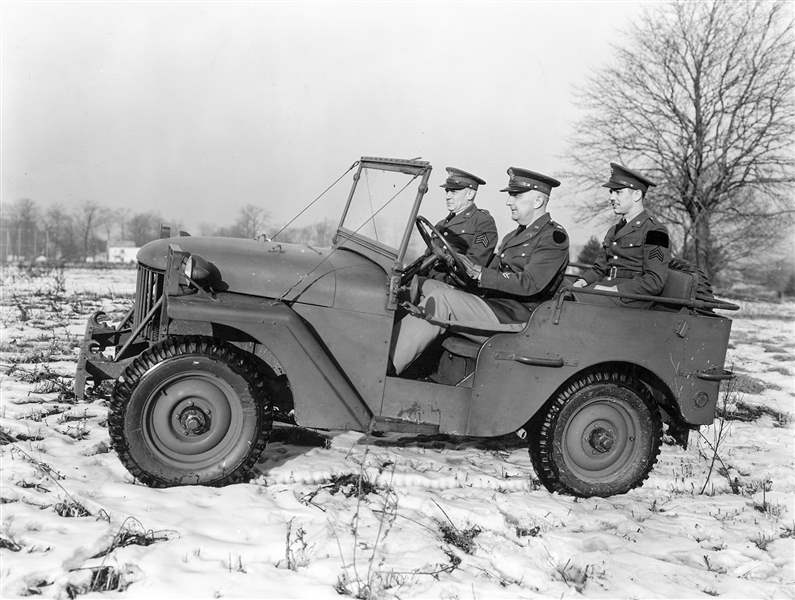
75 YEARS OF JEEP
Original Jeep designed by many minds
Toledo’s Willys-Overland won trademark after war, but Ford, Bantam also contributed
8/7/2016
Army personnel drive a Willys-built jeep in 1940. The final model used traits from Ford’s, Willys’, and Bantam’s submissions. All three companies made jeeps for the military, but Willys-Overland made by far the most.
THE BLADE
Buy This Image
Many have laid claim to the narrative that they created the iconic Jeep, the most American of vehicles, the all-purpose runabout that helped the Allies win World War II.
In truth, the Jeep was birthed by a collaboration of minds from industry and government. Its creation is perhaps one of history’s most interesting examples of multiple visions coming together for a common cause.
“In the end, everybody played a role and everybody played a part,” said Mark Gessler, president of the Maryland-based Historic Vehicle Association. “There was no father of the Jeep. When success happens, there are always many fathers and this is a case where that was absolutely what was happening.”
That’s not to say the Jeep was a wholly altruistic effort. The three main players in its development, the American Bantam Car Co., Ford Motor Co., and Toledo-based Willys-Overland all saw — correctly — the project as a potential moneymaker. And even before the war was over, there were fights over who could trademark Jeep.
RELATED: Celebrating 75 years of Jeep | The brain behind the Jeep’s brawn | Jeep was indispensable to Allied victory
Though current owner Fiat Chrysler Automobiles is celebrating Jeep’s 75th anniversary this year, the concept goes back further. Even before German tanks rolled across Poland in 1939, some U.S. army officials were interested in commissioning a lightweight, all-terrain, open scout car.
Brandt Rosenbusch, manager of historical services at FCA North America, said nothing of that sort existed at the time and the military needed to modernize.
“The U.S. Army was really woefully prepared for war, as most countries were in the 1930s. There wasn’t a light utility vehicle that was open,” Mr. Rosenbusch said. “There wasn’t any quarter-ton vehicles that were four-wheel drive at the time, so that made a huge difference.”
American Bantam, based in Butler, Pa., hired a lobbyist to pitch their light roadsters as a potential candidate. Bantam had already provided earlier samples to the military and likely saw an Army contract as a lifeline that could rescue the struggling carmaker. On July 11, 1940, following a visit to Bantam, the Army’s logistics branch released that set of specifications for their new low-profile, quarter-ton, four-wheel drive truck.
Officials requested bids from 135 companies. Only three companies came back with proposals: Bantam, Ford, and Willys.
Randy Withrow, whose U.S. Veterans Memorial Museum in Huntsville, Ala., owns examples of all three designs, said each one had its own strong points.
The Ford, called the GP, was the most comfortable and had more room, but it was costly and underpowered. The Willys, designated the MA, was the most powerful and significantly lighter after engineers stripped excess weight from an initial prototype. The Bantam Reconnaissance Car was well-liked by testers but not as capable or rugged, he said.
In the end, the military essentially picked from the best attributes of all three. The stamped grille and fuel tank location under the seat came from Ford, while the basic lines were Bantam. Willys was awarded the contract, in large part on the strength of its torquey “Go Devil” four-cylinder engines.
“It really put Willys-Overland ahead of the two other competitors,” Mr. Rosenbusch said. “The Go Devil was the basis of why Willys-Overland got the contract.”
From 1941 to 1945, Willys built 368,000 MBs for military service at its Toledo plant. Ford, licensing the Willys design, would contribute another 281,000. Bantam, which had been first on the scene, didn’t get another vehicle contract after making about 2,700 prototypes and early versions for testing.
The origins of the Jeep name itself are less clear. Historians point to several possibilities, but there’s no wide agreement. It may have been from the GP, as Ford’s vehicle was named. Or it could have been a shortened version of the “general purpose” nature of the vehicle. Another theory holds that the name came from a character in the Popeye comic strip.
Willys-Overland filed to trademark the Jeep name in 1943, igniting a drawn-out fight. In 1948, the Federal Trade Commission instructed Willys to “tone down” its advertising claims on its role in creating the Jeep, noting that the Army, Ford, Bantam, and the Spicer Manufacturing Co., the forerunner to today’s Dana Inc., all deserved credit. Willys finally was given the Jeep trademark in 1950.
“If you’re looking at the home of the Jeep, the concept, the idea, that’s Butler,” Mr. Withrow said. “But if you’re looking at the home of the Jeep and where it was made, it’s Toledo.”